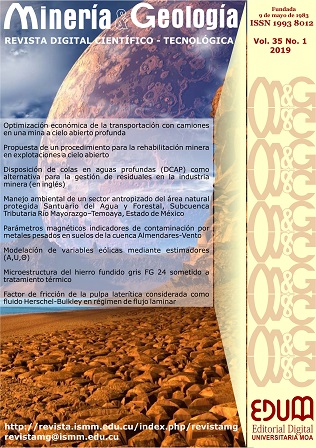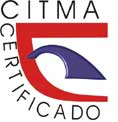Magnetic indicators parameters of contamination by heavy metals in soils of Almendares-Vento basin
Keywords:
anthropogenic contamination, soils, heavy metals, magnetic susceptibility, isothermal remanent magnetization, environmental magnetism.Abstract
In order to verify if the magnetic parameters can be indicators of soil contamination, the relationship between magnetic parameters and the concentration of heavy metals in soil samples from the Almendares-Vento basin was studied. Measurements of magnetic susceptibility, chemical determinations of heavy elements and remanent magnetization, were made. The concentration values in the samples of the heavy elements (Cr, Fe, Ni, Mn, Cu, Zn and Pb) were determined by mass spectrometry with inductively coupled plasma. Magnetic susceptibility yielded higher values towards the upper part of the soil, up to 20 cm deep, which can be attributed to the presence of magnetic material of anthropogenic origin on the soil surface, generated by productive processes at the facilities of the region. It is concluded that increases in the values of magnetic susceptibility are indicators of the increase in the concentration levels of heavy elements for soils of the basin as a consequence of human contaminationDownloads
References
Alfonso-Roche, J. R. 1989: Estadísticas en las Ciencias Geológicas. Tomos I y II. Ciudad de La Habana: Editorial ISPJAE.
Bućko, M. S. 2012: Application of Magnetic, Geochemical and Micro- Morphological Methods in Environmental Studies of Urban Pollution Generated by Road Traffic. Doctoral dissertation. University of Helsinki.
Bućko, M. S.; Magiera, T.; Pesonen, L. J. y Janus, B. 2010: Magnetic, geochemical, and microstructural characteristics of road dust on roadsides with different traffic volumes - case study from Finland. Water, Air, and Soil Pollution, 209(1-4): 295-306.
Chaparro, M. A. E. 2006: Estudio de parámetros magnéticos de distintos ambientes relativamente contaminados en Argentina y Antártida. Ciudad de México: Ed. Geofísica UNAM. ISBN: 970323567-0.
Chaparro, M. A. E.; Lavornia, J. M. y Sinito, A. M. 2013: Biomonitors of urban air pollution: Magnetic studies and SEM observations of corticolous foliose and microfoliose lichens and their suitability for magnetic monitoring. Environmental Pollution, 172: 61–69. doi:10.1016/j.envpol.2012.08.006
Chaparro, M. A. E.; Marié, D. C.; Gogorza, C. S.; Navas, A. y Sinito, A. M. 2010: Magnetic studies and scanning electron microscopy - x-ray energy dispersive spectroscopy analyses of road sediments, soils, and vehicle-derived emissions. Studia Geophysica et Geodaetica, 54(4): 633-650.
Day, R.; Fuller, M. y Schmidt, V. A. 1977: Hysteresis properties of titanomagnetites: grain-size and compositional dependence. Physics of the Earth and planetary interiors, 13(4): 260-267.
Comunidad Económica Europea. 1986: Directiva 86/278/CEE del Consejo de 12 de junio de 1986 relativa a la protección del medio ambiente y, en particular, de los suelos, en la utilización de los lodos de depuradora en agricultura. Diario Oficial L(181): 0006–0012. Consultado: 3 abril 2018. Disponible en: http://data.europa.eu/eli/dir/1986/278/oj
Fabian, K.; Reimann, C.; McEnroe, S. A. y Willemoes-Wissing, B. 2011: Magnetic properties of terrestrial moss (Hylocomium splendens) along a north-south profile crossing the city of Oslo, Norway. Science of the Total Environment, 409(11): 2252-2260.
Gautam, P.; Blaha, U.; Appel, E. y Neupane, G. 2004: Environmental magnetic approach towards the quantification of pollution in Kathmandu urban area, Nepal. Physics and Chemistry of the Earth, parts A/B/C, 29(13-14): 973-984.
Hrouda, F. 1994: A technique for the measurement of thermal changes of magnetic susceptibility of weakly magnetic rocks by the CS-2 apparatus and KLY-2 Kappabridge. Geophysical Journal International, 118(3): 604-612.
Jordanova, D.; Petrov, P.; Hoffmann, V.; Gocht, T.; Panaiotu, C.; Tsacheva, T. y Jordanova, N. 2010: Magnetic signature of different vegetation species in polluted environment. Studia Geophysica et Geodaetica, 54(3): 417-442.
Marié, D. C.; Chaparro, M. A. E.; Irurzun, M. A.; Lavornia, J. M.; Marinelli, C.; Cepeda, R.; Böhnel, H. N.; Castañeda, A. G. y Sinito, A. M. 2016: Magnetic mapping of air pollution in Tandil city (Argentina) using the lichen Parmotrema pilosum as biomonitor. Atmospheric Pollution Research, 7(3): 513-520.
Pedroso, I. 2013: Zonación de la contaminación por metales pesados en la cuenca del Almendares según mapeo de la susceptibilidad magnética Minería y Geología, 29(3): 1-17.
Rodríguez, M.; Muñiz, O.; Montero, A.; Araújo do Nascimento, C. W.; Calero, B.; de Aguiar, A. M.; Chávez, N.; Leal, A. y Hernández, M. 2014: Valores de calidad para metales pesados en suelos de Cuba. En: XX Congreso Internacional de Ciencias Agrícolas 2014. Disponible en: http://ediciones.inca.edu.cu/files/congresos/2014/CD/memorias/ponencias/talleres/ENP/ra/ENP-O.05.pdf
Published
How to Cite
Issue
Section
Copyright (c) 2019 Ida Inés Pedroso-Herrera

This work is licensed under a Creative Commons Attribution-NonCommercial 4.0 International License.
- Authors retain copyright and guaranteeing the right magazine to be the first publication of the work as licensed under a Creative Commons Attribution-NonCommercial that allows others to share the work with an acknowledgment of the work's authorship and initial publication in this journal.
- Authors may establish separate supplemental agreements for the exclusive distribution version of the work published in the journal (eg, place it in an institutional repository or publish it in a book), with an acknowledgment of its initial publication in this journal.
- Authors are allowed and recommended to disseminate their work through the Internet (e.g., in institutional telematic archives or on their websites) before and during the submission process, which can produce interesting exchanges and increase citations of the published work. (See The effect of open access)










